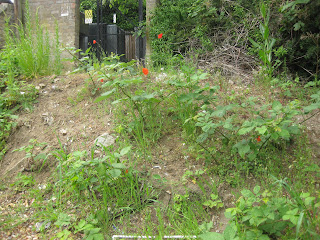Their success can be the gardener's downfall, and the speed with which weeds can take over a bare patch of earth impressive, if sometimes a little frustrating! There are many areas around here where there are reminders of what sometimes happens when the earth reveals what's been hiding underneath, like these poppies growing (and glowing) where some garden waste was dumped.
At the open garden event we attended last week I saw that most of the gardens had deliberate 'wild' areas where, with a bit of judicious weeding out of the real 'bullies', wild flowers (and what might otherwise be termed 'weeds') were thriving (as they would, of course). For instance, we have single dead nettles popping up all over the place, but I saw a controlled patch of them in one garden that helped make them look deliberate and, en masse, much prettier. So, now I'll try to designate one area as a 'no-pull' space for them - if there are any left after all my weeding!
As a very new gardener, I'm quite particular in my lack of knowledge about weeds in the garden. There are those I know and like, those I know and dislike, those that I happily assume are flowers until told otherwise (and remove as soon as I find out about their rampant nature) and those I realise I should have left well alone. Wild garlic, we miss you.
We can't call our 'grassy bit' a lawn - it's definitely not Wimbledon standard. We have huge numbers of weeds/plants popping up, and they are that bit more difficult to eradicate from grass. Some people don't like daisies but I do welcome them at least, and I'm very happy that, after the grass has had a haircut, they are back again a few days later. On the other hand I do pull out dandelions!
Our main aim is to encourage bees and other wildlife into the garden and, with my thoughts on weeds and wildflowers, I then spotted this item on the BBC news website, all about a new 'grass free lawn' in London. It sounds wonderful, and I want one! It had always been our plan to turn the scrubby patch of grass at the front of the house into something akin to a wildflower meadow, but that's a little bit more difficult to do than one might imagine - it's not just 'chuck a few seeds on and wait for rain'. We have tried to fill the space with flowers and shrubs, slowly reducing the grassy area bit by bit. Now I'm thinking, we could simply add thyme, chamomile, pennyroyal and Corsican mint to the daisies and clover that already exist there, and I would never have to drag the lawnmower round to the front of the house ever again!
This would also blend in nicely with the weedy bit at the front of the garden wall, where I've encouraged the prettier flowering weeds, like buttercups and clover, rather than the nettles and thistles. There are enough of those on the grass verges, so I don't feel too bad about pulling them out. The idea is to try to disguise the wall, which saves on pulling it down, rebuilding or re-rendering it.
I'm interspersing these naturally occurring plants with some sown native wildflower seeds (with no success as yet, sadly) and trying to encourage the Mexican daisies (which I love) to spread as quickly as possible!
In the article about the 'need for weeds' the writer talks of the digging of a well in London which unearthed the remains of weeds from 250, 000 years ago that grew again in London after the Blitz. When a field near here was being surveyed with a view to building new houses there, I had hoped that the deep archeological trenches might unearth something interesting (unfortunately not) and that the field would then be decorated with a herringbone pattern of poppies or cornflowers or something interesting once the earth was replaced.
Again, no. Instead, a year later, the usual field of (lovely) buttercups, nettles and cow parsley, is striped with grey/blue grasses, like the dull wakes of invisible ships on a green sea. Of course, I shall probably find out later that these are grasses not seen in the region since Roman times, and are hugely significant...







No comments:
Post a Comment